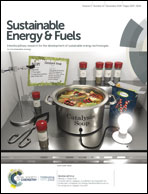Dye-sensitized solar cells using fluorone-based ionic liquids with improved cell efficiency†
Abstract
Six trihexyltetradecylphosphonium chloride (P6,6,6,14Cl) based ionic liquids (IL) with dianionic fluorone derivatives were synthesized with total exchange of chloride from the dianionic dye: Fluorescein (a), Rose Bengal (b), Phloxine B (c), Eosin B (d), Eosin Y (e) and Erythrosin B (f). Spectroscopic characterization of these viscous salts indicated the presence of the expected 1 or 2 strong absorption bands. A total of 12 compounds, as sodium (from a to f) or as trihexyltetradecylphosphonium dianion salts (from a′ to f′), were used for sensitization of nanocrystalline TiO2. Here, we report the sensitization activity of these metal free dyes in terms of current–potential curve, open-circuit potential, fill factor, and overall solar energy conversion efficiency which have been evaluated under 100 mW cm−2 light intensity. We developed a strategy to improve the light harvesting of these conventional dyes by simple cationic exchange which was accompanied by a minimum of 30% increase in the cell photovoltaic conversion efficiency. Also, for Eosin B the binding to TiO2 apparently allows reduction of the –NO2 electron-withdrawing group to –NO22−. This provides a new interaction between the reduced nitro group and the TiO2 surface, reflecting an improvement in the overall DSSC performance reaching its maximum of 0.65% efficiency after light DSSC soaking. Factors that improve DSSC performance like aggregate inhibition, increment of the electrode's quasi-Fermi level and slight red shift in the absorption spectra of the tested anionic dyes were achieved by simple cationic exchange.



 Please wait while we load your content...
Please wait while we load your content...